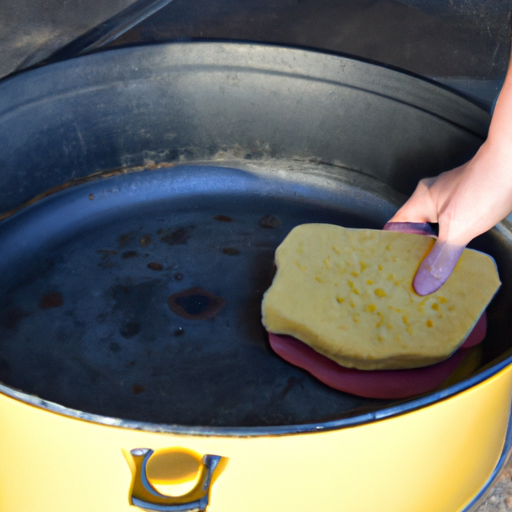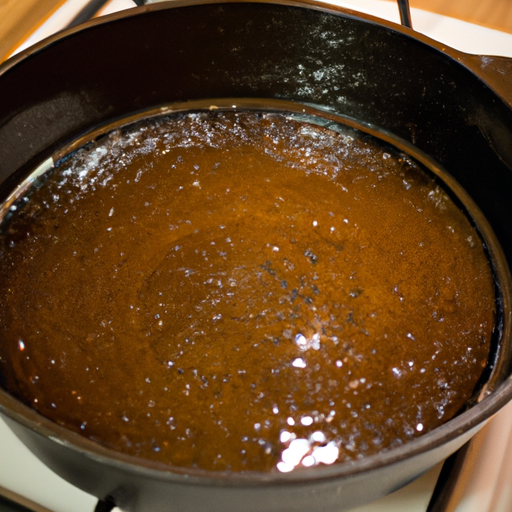JohnDoe
These tips were really helpful. My Dutch oven looks brand new after following these cleaning steps.

Before you start cleaning your Dutch oven, make sure it has cooled down completely. Attempting to clean a hot Dutch oven can lead to burns or other accidents. Once it has cooled, remove any excess food or debris from the pot using a wooden spoon or spatula. Avoid using metal utensils as they can scratch the surface of the Dutch oven.
Fill the Dutch oven with warm water and a few drops of mild dish soap. Let it soak for about 15 minutes to loosen any stuck-on food. After soaking, use a non-abrasive sponge or brush to scrub the interior of the Dutch oven. Be gentle but thorough, paying extra attention to any stubborn spots. For tough stains, you can create a paste with baking soda and water and apply it to the affected areas.
If there are still stubborn stains or burnt-on residue after scrubbing, you can try boiling water and vinegar in the Dutch oven. Fill it about halfway with equal parts water and vinegar, then bring it to a boil. Let it simmer for a few minutes before removing it from the heat. Allow the mixture to cool down before emptying it and scrubbing the Dutch oven again. This method can help remove even the toughest stains.
After cleaning, rinse the Dutch oven thoroughly with warm water to remove any soap residue. Use a clean towel or paper towel to dry it completely. To prevent rust and maintainthe seasoning of your Dutch oven, it's important to apply a thin layer of oil to the interior and exterior surfaces. You can use vegetable oil, canola oil, or any other oil with a high smoke point. Apply the oil using a paper towel or cloth, making sure to cover all surfaces. Place the Dutch oven upside down in a preheated oven at 350°F (175°C) for about an hour. This process helps to create a protective layer and maintain the seasoning of the Dutch oven.
To ensure the longevity of your Dutch oven, proper storage and maintenance are essential. After each use, make sure to clean and dry the Dutch oven thoroughly before storing it. Store it in a cool, dry place to prevent moisture and rust. Avoid stacking heavy items on top of the Dutch oven, as this can cause damage. Regularly inspect the Dutch oven for any signs of wear or rust, and reapply a thin layer of oil as needed to maintain its seasoning.

| Cleaning Method | Effectiveness | Safety |
|---|---|---|
| Warm Water and Soap | Effective for general cleaning | Safe for most Dutch ovens |
| Baking Soda Paste | Effective for stubborn stains | Safe for most Dutch ovens |
| Boiling Water and Vinegar | Highly effective for tough stains | Avoid using on enameled Dutch ovens |
| Scrubbing with Salt | Effective for removing grease and grime | Avoid using on non-stick or seasoned Dutch ovens |
| Oven Self-Cleaning | Very effective for deep cleaning | Only suitable for certain types of Dutch ovens |
By following these steps, you can keep your Dutch oven clean and in excellent condition for many years. Proper cleaning and maintenance will not only extend its lifespan but also ensure that your meals continue to turn out delicious every time you use it.
JohnDoe
These tips were really helpful. My Dutch oven looks brand new after following these cleaning steps.
CookingEnthusiast
I've always struggled with cleaning my Dutch oven, but this guide made it so much easier. Thank you!
FoodieForever
The article provided some useful tips, but I wish there were more alternative cleaning methods mentioned.
KitchenQueen
I accidentally burnt some food in my Dutch oven, but this article helped me restore it to its original condition. Highly recommended!
HealthyEater
I appreciate the emphasis on using natural cleaning methods. It's important to avoid harsh chemicals when cleaning cookware.
|
|
Diana Grimes is a culinary expert with years of experience in cooking with Dutch ovens. She has a passion for sharing her knowledge and tips on how to properly care for and maintain these versatile cooking tools. |